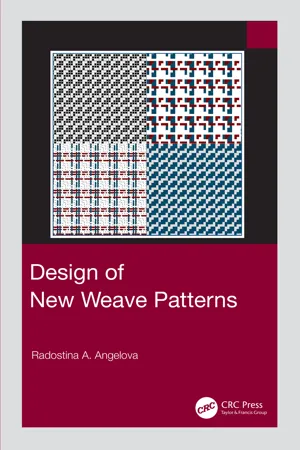
- 154 pages
- English
- ePUB (mobile friendly)
- Available on iOS & Android
eBook - ePub
Design of New Weave Patterns
About this book
This book presents a systematic study on methods used for the creation of weave patterns for simple structures. Firstly, it explains known techniques for designing new weave patterns classified as patterns merge, motifs, patterns insertion and change of the displacement number. These are discussed as possibilities to create different textures and weaving effects supported by figures of patterns, colour view, and fabric appearance simulation. Secondly, it explains original methods for design of new weave patterns based on Boolean operations, musical scores, written texts and braille alphabet, including transformations performed, advantages/disadvantages, possible applications and designs.
Frequently asked questions
Yes, you can cancel anytime from the Subscription tab in your account settings on the Perlego website. Your subscription will stay active until the end of your current billing period. Learn how to cancel your subscription.
At the moment all of our mobile-responsive ePub books are available to download via the app. Most of our PDFs are also available to download and we're working on making the final remaining ones downloadable now. Learn more here.
Perlego offers two plans: Essential and Complete
- Essential is ideal for learners and professionals who enjoy exploring a wide range of subjects. Access the Essential Library with 800,000+ trusted titles and best-sellers across business, personal growth, and the humanities. Includes unlimited reading time and Standard Read Aloud voice.
- Complete: Perfect for advanced learners and researchers needing full, unrestricted access. Unlock 1.4M+ books across hundreds of subjects, including academic and specialized titles. The Complete Plan also includes advanced features like Premium Read Aloud and Research Assistant.
We are an online textbook subscription service, where you can get access to an entire online library for less than the price of a single book per month. With over 1 million books across 1000+ topics, we’ve got you covered! Learn more here.
Look out for the read-aloud symbol on your next book to see if you can listen to it. The read-aloud tool reads text aloud for you, highlighting the text as it is being read. You can pause it, speed it up and slow it down. Learn more here.
Yes! You can use the Perlego app on both iOS or Android devices to read anytime, anywhere — even offline. Perfect for commutes or when you’re on the go.
Please note we cannot support devices running on iOS 13 and Android 7 or earlier. Learn more about using the app.
Please note we cannot support devices running on iOS 13 and Android 7 or earlier. Learn more about using the app.
Yes, you can access Design of New Weave Patterns by Radostina A. Angelova in PDF and/or ePUB format, as well as other popular books in Art & Art Techniques. We have over one million books available in our catalogue for you to explore.
Information
Section I
Classical Methods for Design of New Weave Patterns
1 | Brief History of Weave Patterns |
The woven fabrics are 3D macrostructures produced due to the interlacing of at least two sets of threads: vertical (warps) and horizontal (wefts). Usually, the woven fabric is produced on a weaving machine (loom). Figure 1.1 shows a picture of a handloom, and Figure 1.2 shows a modern air-jet jacquard weaving machine.
The macrostructure of the woven fabric consists of two levels (Figure 1.3):
• Mesostructure, formed by the threads: yarns of filaments;
• Microstructure, consisting of fibers that are spun into yarns or monofilaments that constitute the filaments (polyfilaments).
The Latin word textilis means woven. The modern term textiles is frequently associated with woven fabrics, but nowadays the textiles can have three different types of a macrostructure: woven, knitted, and nonwoven.
The most accessible and probably first used by the humans fibers for textiles were extracted from lime tree, oak, willow, or elm. Among them non-fibrous raw materials were also used, applying the same principles of interlacing flexible branches or reed. Flax is considered to be the earliest domesticated plant, followed by hemp: both of them associated with Asia as a homeland. Kvavadze et al. (2009) reported the discovery of wild flax dyed fibers, used in a fabric, in the Dzudzuana Cave in Georgia, dated from 32,000 to 26,000 years BP. Though the appearance of some disagreements (Bergfjord et al., 2010), these flax fibers are thought to be the oldest evidence of textiles used by humans.
In Europe, the oldest artifact for textiles/basketry use dates back 25,000–27,000 BP, discovered in Dolní Vestonice I, Czech Republic (Soffer et al., 2001). The next oldest proof of fiber-based technology developed by humans came from the Sea of Galilee in Israel, Ohalo II: Z-twist cordage from an unknown plant species was dated to be produced 19,300 years BP (Nadel et al., 1994).
The oldest evidence for textiles production in Asia comes from the Far East (Derevyanko & Medvedev, 1995) and dates to 13,500 BP. In North America, the oldest textiles artifacts are dated to be produced around 11,000 years BP (Andrews & Adovasio, 1996) and in South America, in Monte Verde, Chile, dated around 13,000 BP (Adovasio, 1997).
The oldest weave pattern, used by humans, is the plain weave. Long before the manufacturing of the first textile, it was applied for basketry production. In the plain weave, the first weft thread goes alternately under the first warp thread, then over the second warp thread, etc. The second weft thread goes first over the first warp thread, then under the second warp thread, etc. Thus, a sta...
Table of contents
- Cover
- Half Title
- Title Page
- Copyright Page
- Table of Contents
- Foreword
- Preface
- Acknowledgments
- Author
- SECTION I Classical Methods for Design of New Weave Patterns
- SECTION II New Methods for Design of New Weave Patterns
- Index